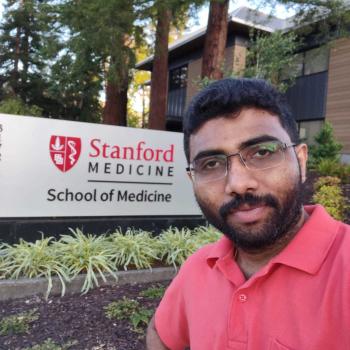Bio
Robin Augustine is a bioengineer with a keen focus on designing and developing various biomaterials and devices that can support, replace, or repair damaged tissues or organs. I completed my Ph.D. in Nanoscience & Nanotechnology from Mahatma Gandhi University in Kottayam, India.
His specific areas of interest include but are not limited to skin substitutes, wound dressings, tissue engineering scaffolds, bioprinted artificial tissues/organs, and other biomaterials. He is passionate about utilizing his knowledge and expertise in the field to contribute to the development of new and innovative solutions that can improve the quality of life for people.
Currently, he is a part of the Interventional Radiology Innovation at Stanford (IRIS) at the Radiology Department of Stanford Medicine headed by Dr. Avnesh Thakor, where he is working on developing novel tissue engineering approaches specifically for pancreatic regeneration applications.
Current Role at Stanford
Dr. Robin Augustine's current research interests revolve around three fascinating areas: graphene-based bioscaffolds, islet transplantation, and synchronized cellular response.<br/><br/>In the field of graphene-based bioscaffolds, Dr. Augustine actively explores the potential of graphene as a biomaterial for tissue engineering. With its unique properties, graphene offers exceptional opportunities for developing innovative bioscaffolds. Dr. Augustine aims to design and engineer graphene-based materials that can provide structural support, promote cellular adhesion and growth, and enhance tissue regeneration. Leveraging the exceptional properties of graphene, such as its mechanical strength, electrical conductivity, and biocompatibility, Dr. Augustine's goal is to contribute to the development of advanced bioscaffolds for various applications in regenerative medicine.<br/><br/>Another area of Dr. Augustine's research focuses on islet transplantation, particularly in the context of treating diabetes. Islet transplantation holds promise as a potential cure for type 1 diabetes, involving the transfer of insulin-producing islet cells into the recipient's pancreas. Dr. Augustine investigates strategies to optimize islet transplantation techniques, improve the long-term viability of transplanted islets, and enhance their functionality. The ultimate objective is to contribute to the development of more effective and sustainable approaches for islet transplantation, with the aim of improving the quality of life for individuals living with diabetes.<br/><br/>Dr. Augustine also explores the field of synchronized cellular response, recognizing its crucial role in tissue development, regeneration, and repair. The focus is on understanding and manipulating the synchronized cellular response in complex tissue systems. By studying the intricate signaling pathways and cellular interactions, Dr. Augustine aims to identify key factors and mechanisms that regulate coordinated cellular behavior. This knowledge can inform the development of strategies to enhance tissue regeneration and repair processes, potentially leading to improved outcomes in various biomedical applications.<br/><br/>Through research in graphene-based bioscaffolds, islet transplantation, and synchronized cellular response, Dr. Augustine strives to contribute to the advancement of tissue engineering, regenerative medicine, and the development of innovative therapies for complex medical challenges.


